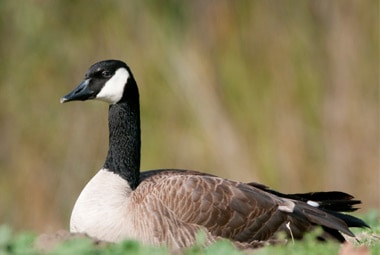
The most common species of goose to become problematic for homeowners is the Canadian goose. They are a migratory species that are native to the arctic and temperate regions of North America, but can also be found migrating to parts of Northern Europe.
| Pest Identification | |
|---|---|
| Recognition | The Canadian goose is a large species of wild goose. The adults can weigh between 10 and 20 pounds and grow to be 22-45 inches in length with a 50-73 inch wingspan. They have a long black neck, a black head with white patches on their face, and a white chinstrap. Their breast is tan and their back is brown. Other distinctive characteristics include a wide flat bill and large webbed feet. |
| Biology | The Canada goose begins mating in their second year of life. They are a monogamous species, so once they find a mate they will remain together for life. If a male or female dies they find a new mate. They create a shallow nest lined with plants in an elevated area that is close to a water source. The female lays an average of 2-9 eggs and she incubates them for 24-28 days. Once the goslings hatch they need to be protected by their parents but they can walk, swim and find food all on their own right away. They remain with their parents until after the spring migration. |
| Habits | Canadian geese can be found living in or near marshes, man-made lakes and ponds, industrial parks, golf courses, and in residential neighborhoods. All of the above environments provide geese with all the food, resting, and breeding sites that they need. Canadian geese can become problematic for both home and business owners. They can destroy lawns and landscaping, leave their droppings all over, and can become very aggressive when they protect their nests and young. |
| Prevention | The prevention and control of Canadian geese can be difficult because of their nature and because Canada geese are federally protected under the Migratory Bird Treaty Act, MBTA (16 USC.703-711). They can be taken only with a permit issued by the US Fish and Wildlife Service and state wildlife agency (i.e., when other control methods have been attempted to no avail). However, there are steps that can be taken to control these pests by property owners and by professional wildlife control experts. If geese have overtaken your property Rottler professionals can work with you to help deter and control them through environmental control, habitat modification, and chemical control. -Limit their food sources by making sure that they are not being purposely fed on your property. -Plant inedible landscaping on your property. -Use exclusion methods that include the use of fences and netting to prevent them from landing in or on problem areas. -Live trapping geese and relocating them with the help of a trained professional can be done during molting season if a permit is acquired. -The application of non-toxic chemicals (taste) repellants can be use on lawns and low landscaping to make the area less desirable for the geese. -In special situations a toxicant can be used to control pest geese under the guidance of a USDA-APHIS-WS agent with a special permit. |

